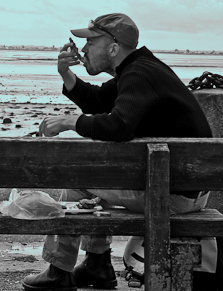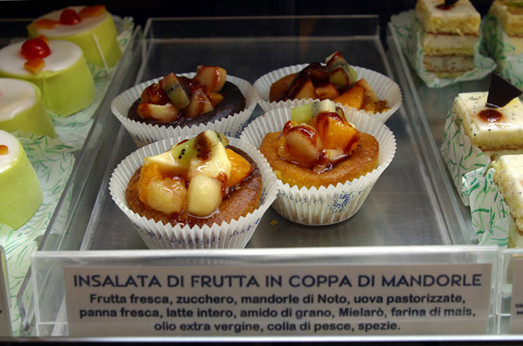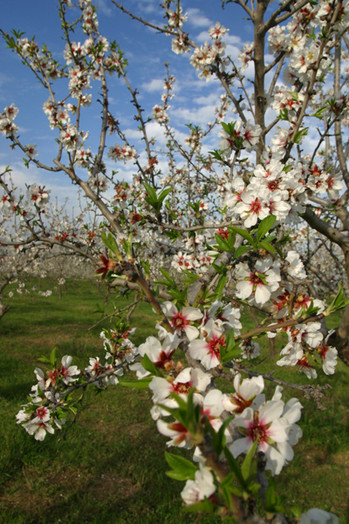LEAVE YOUR COMMENT
Joe Ray
Food & Travel / Words & Photos
Friday, March 23, 2007
The Four Senses of Corrado Assenza
Talk with enough chefs worth their salt and they’ll almost inevitably take a good hunk of time to preach the virtues of the importance of raw materials.
At an unassuming café in the southern Sicilian town of Noto, pastry master Corrado Assenza dwells on such things for about 20 seconds before he launches into the culinary stratosphere on a gastro-philosophical jag that explains both the primacy of the almond and the overall state of Sicilian pastry making.
Leaving two shot glasses of almond milk in front of Francesco and me, Italy’s 2006 pastry chef of the year walks away, returning only when we’ve finished. He then places a jelly jar of almond cream on the table saying, “This is the base. From this, you can make everything.”
It’s pretty much the first thing he’s said and it’s not terribly clear what ‘everything’ means, but he explains.
Mixed with water, almond cream becomes almond milk. Mixed with a bit of marmalade, it’s the perfect center to a delicate brioche.
“These are the bones,” he says, pointing at the jar on the table while grabbing my knobby wrist and shaking it, “We need bones to make this body.”
‘This body’ is Sicilian pastry as a whole and I feel downright flattered to serve as the example.
“We have about 80 products that we make here and about 30 that use almonds and still others where it’s just to give a bit of the taste.”
Despite more than 1,000 years of Sicilian almond history, in both sweet and savory dishes, Assenza is not sitting around just recreating the classics. His prima case a fumo (“before it became smoke”) is layers of what he calls tobacco cream, cocoa beans, almond and marzipan slices, topped with a strawberry cream. He’s also come up with what he calls insalata di frutta in coppa di mandorle (“fruit salad in an almond cup”), a curious and delicious cousin to strawberry shortcake, where the ingredients of the ‘cup’ include almond flour and olive oil (butter’s a rare bird here).
If this is what the future will be like, visitors to Noto should look forward to getting older in Sicily.
“We have too many ways to apply our tradition. We can copy the past, or use our ability to…interpret it with our eyes, mouth and senses,” he says. “I prefer the second way.”
One of Assenzo’s biggest preoccupations is getting this mix of old and new to the people who might understand or appreciate it the least: tourists and the gastronomically uninterested.
“I remember the when travelers used to come through here in the 60s,” he says, calling the set “Byron Travelers” as they might set up camp in Noto for months at a time.
Now, however, people have morphed into what he refers to – without bitterness – as ‘click and run’ tourists.
So do the lucky ones who happen into Caffe Sicilia get what he’s trying to do?
Disturbingly, he dodges the question a bit, but answers with optimism.
“Now, people arrive with their guide books in hand. I say, ‘Please, close your eyes. Use your ears.’ People aren’t unable to use their senses,” he affirms.
“The key is food. Sweet food.”
Along with their sense of hearing, he says he tries to create a connection to Sicily using color, texture and flavor.
He also uses basil ice cream.
It’s disarming stuff that short circuits your senses, leaving you with only goose bumps and a grin as descriptors.
For Assenzo, basil ice cream and a dreamy almond sorbet – both of which have a minimalist’s ingredient list – are tools to reach ‘click and run’ kids from Sicily and abroad.
“They have other kinds of experience, so you should commence with something special,” he explains with Zen gentillesse. “You need to help them arrive with something simple.”
It isn’t as simple as it sounds to get something like this to work.
“We use technology so we don’t damage the taste of the basil leaves,” he explains. “It took one and a half years to come up with something so we could arrive at this.” In Sicily, where man’s relationship with technology is peculiar at best, this guy is an outright visionary.
So, after discussing his raft of offerings and their philosophical and near-spiritual uses, what’s his favorite dessert?
“It’s the next one. It’s the one I haven’t thought of yet.”
In the meantime, he’ll let his creations be ambassadors of the good stuff to locals and tourists alike.
“Each cake,” he concludes, “is part of a tale that brings you into our land.”
This is Joe Ray reporting from the Motherland.


